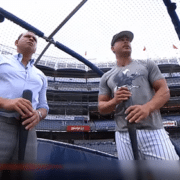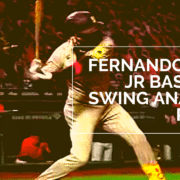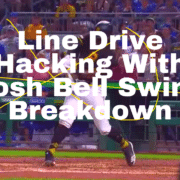Disconnected Front Arm Swing Drills: STOP Hitting Inside Out, Casting, Bat Drag, & Looping For Baseball Or Softball Batting
Discover how to spot disconnected front arm swing drills and learn how to STOP hitting inside out, casting, bat drag, and looping baseball or softball swings. Perry Husband (EffectiveVelocity.com) and I will discuss bat lag drills for power validated by science.
5,000 Swing Experiments Validate Locked Out Lead Arm Is Superior To Bent
Here’s the Hitting Jam Session Interview Collection with Perry Husband:
- Why You Should Not Teach Hitters To Hit Homers?
- What’s The Biggest Mistake Coaches Make In Boosting Ball Exit Speeds
- How To Make Teaching Proper Weight Shift In Swing More Understandable To Hitter
- Teach: How To STOP Hitting Excess Of Ground-balls & Fly-balls
- [YOU ARE HERE] 5,000 Swing Experiments Validate Locked Lead Arm Is Superior To Bent
- Overload Bat Training: Hitting Has To Work Butt Off To Resist “Casting”
Here’s what we discuss in this episode:
- Instructors confusing what “casting” is and is not,
- What if only fastball Mike Trout gets is what produces the 80.8-mph avg. BES, would that change his offensive stats?
- Hitter using bent lead arm comes at a cost,
- “Deep barrel dump” – great barrel path for down/away pitches, but TERRIBLE for up/inside pitches,
- And much more!
Hitting Jam Session 5 above jumps right into the conversation already started…
SCIENCE-BASED TRAINING:
Improve your hitting strategy dramatically by applying human movement principles.
Learn not only how and what to train but also the science behind the methods.
Show Notes
- At about the 2-minute mark, disclaimers…I was a skeptic on the locked lead arm since about 2 years ago, some out there cannot subscribe to a locked lead arm BECAUSE of what they teach – the “deep barrel dump” on every pitch depth, instructors are confusing what “casting” is and is not, it’s not a locked lead arm, it is a deep barrel dump regardless of pitch depth, nobody is 100% right or wrong, if stay in Science, then most will come to the same conclusions (on macros – maybe not micros),
- At about 5-minute mark, what is and is not working for Mike Trout – bent lead up arm v. locked lead arm, fastballs up and in 80.8-mph avg. BES in 2018 (bent lead arm), and down and away 101.8-mph avg. BES (locked lead arm), what if the only fastball he gets is what produces the 80.8-mph avg. BES would that change Mike Trout’s offensive stats? Trout is hitting in a target rich environment where pitchers are throwing fastballs DOWN and off speed and breaking stuff UP, which puts timing that sequence VERY similar – easier to hit, pitchers are STUPID to keep fastballs down to him, Perry’s categories for pitches: #1’s – fastest version of the fastball – 96+ mph, #2’s – slowest version of the FB and fastest version of off speed (splitter/cutter/slider up in the zone), #3’s – slower versions of splitter/cutter/slider down in the zone, and #4’s – curveballs, Trout killed 2’s, 3’s, and 4’s, Perry referenced the SBNation article about Trout on Effective Velocity, article had wide reach and pitchers started pounding Trout up – and he adjusted to an up/in approach, changed his attention of where he focused and hunted, can only cover so much as a hitter when it comes to hitting 1, 2, 3, and 4’s,
- At about 14-minute, 30-secs mark, hitter using bent lead arm comes at a cost, in Trout’s case 80-mph avg. BES v. 101-mph BES, split A/B testing metaphor on Facebook ad changing only 1 thing – see what ad wins out over being shown randomly to an audience, split A/B test locked lead arm versus keeping it bent, what if all FB’s down/away disappear to Trout? What would happen to his numbers? What happens when an EV minded pitcher like DeGrom, Scherzer, Verlander, Bauer face Trout or Miggy? What about bettering reaction time? What happens to policeman when you take away time? Ugly stuff – they have less time to make a decision (Perry referenced the book Blink
), give extra time, see pitches easier, slow down fast stuff and speed up slow stuff…allows Trout to cover A LOT of pitches with same timing, as a pitcher you’re more likely to get away with hanging off speed or breaking stuff up in the zone than a fastball down and/or away,
- At about 27-minute, 30-secs mark, Perry talks about how Jacob DeGrom ONLY mixed in a higher percentage of fastballs up in the zone (61% of the time – avg. postseason team was 44%) one year and cut his ERA in half! Debunking the “deep barrel dump” – great for pitches on the outer 1/3 of plate or lower in the strike zone, but is TERRIBLE barrel path for inner 1/3 to inner half part of plate, some confuse “long swing” with locked lead arm, but it’s because of casting or deep barrel dump, Perry talks about the ball bungee attached with surgical tubing experiment: found bigger the stretch, the faster and less time it takes ball to hit wall, connection to hitting is taking slack out of the system (more elastic energy built up!), fence drill – can do drill with locked lead arm if hold angle of bat close to following shoulder, keep 90-degree wrist angle tension w/ locked lead arm versus bent,
- At about 36-minute, 30-sec mark, Stanton, Donaldson – when they hit 114-mph BES they’re in a closer to lead arm lock out position, why not find out how to figure out how to get hitters doing it versus explaining it away, multiple 100-mph BES younger hitters hitting balls off the tee, how many 100-mph BES players are being cheated by inferior mechanics, locked lead arm doesn’t just increase power but it also improves consistency of sweet spot to ball, Perry’s done 5,000 swing experiments on locked out front arm (Jay Bell was most known), in golf if golfers could hit it farther with a bent lead arm, then driving ranges across the world would be using bent lead arm, goal is still the same in baseball as in golf – hit it at max
- At about 42-minute, 30-sec mark, locked lead arm being longer…it’s not a question of locked lead arm causes long or casting swing – it’s about when the hitter “releases” the barrel from the rear shoulder that causes the long or casting swing, the stubborn “deep barrel dump” barrel path being taught will become extinct when pitchers get more EV efficient and begin using hard stuff up in the zone, even if pitchers miss their mark by a foot they’ll still be effective – execute one in three pitches, you’ll be a super star just as long as you understand what your misses are doing, hitters must apply 100/100 all the time – 100% on-time, 100% effective, pitchers like Scherzer will be the norm and not the exception, dumping barrels on all pitches WILL NOT work, can lock at load or at start of the turn – objective is to take slack out before the turn,
- At about 56-minute mark, pitcher and hitter adjustments over the decades: Bob Gibson days attacking up, hitters adjust and get good at driving up, then in 70’s and 80’s pitchers attacked down in the zone, now pitchers are beginning to adjust back up again, Perry says we’ll see one more drop with hitting, which will force hitters to rock bottom, buy a little more time swinging with bent front arm but at what costs, going to be really hard when hitter sees 100-mph up, then followed up with curveball that looks the same in the tunnel and drops, how longer arms effects contact points, all data right now is based on control of bent front arm, JUST TEST IT! CLICK HERE for testing protocol Perry and I have talked about in these Jam Sessions, any change you make MUST positively affect ball exit speed AND frequency of line drives, message to those who are anti-tee, bent lead arm ball exit will be close to the same off tee and LIVE
- You can find Perry Husband at EffectiveVelocity.com, use EV25 coupon code for any of the online courses. @EVPerryHusband on Twitter, and @PerryHusband on Facebook
- My offer…FREE Catapult Loading System 2nd edition print book – just pay $8.95 shipping and handling (retails on Amazon for $19.97) – in addition you’ll get our essential consistent power online video mini-course Power Hitter 2.0: Engineering The Alpha: https://www.truthaboutexplosiverotationalpower.com/pl/60039
- Fix Late Swings Fast: 2025 Pitch Recognition & See-Decide-Swing Training for Youth Baseball Power Hitters - October 6, 2025
- Safe Youth Weighted Bat Training: Proven Overload/Underload Drills to Increase Exit Velocity in Games Starting Tonight - September 29, 2025
- AI Coaching Course 2025: Youth Baseball & Softball Practice Plan + Off-Season & In-Season Workout Builder Fast - September 23, 2025













Joey do you agree with this? I think this goes against what you have always taught about figure skaters turning faster with their arms tucked closer to their body and slower as they get further away.
Hey Brad, this is something I’ve been tinker and testing with for the past 2 years. Yes, the ice skater spins faster with arms in, but at the cost of inertial mass. When she extends her arms out she increases her inertial mass, but at the cost of turning speed. It’s definitely worth testing 😀
Joey,
Great stuff as always. We have had this discussion many times. Several things:
1. Are we throwing the law of the conservation of angular momentum out the window? I believe that a longer lever is a stronger lever.
2. Mike Trout: do you think he is guilty of “dumping the barrel?”
3. Everyone knows that Trout is vulnerable up and in. He admitted that in an interview with ARod prior to a Sunday night game on ESPN. Would he be able to hit those fastballs up more effectively with a barred front arm?
4. What role does his head position – tilted towards his rear shoulder play in his inability to hit the high pitch? Does his head position reduce his angular speed?
Joe, great points, here are my responses:
1. The Conservation of Angular Momentum says when turning speed increases, inertial mass decreases. And when inertial mass increases, turning speed decreases. We’re absolutely using it, however, the difference is when the barrel leaves the shoulder on pitches up/inside.
2. Right now, it’s a target rich environment, pitchers are throwing soft up in the zone (this speeds up slow stuff), and throwing hard stuff down in the zone (this slows down fast stuff). Mike Trout is just living in the middle. But against EV efficient pitchers, he has a challenge. Watch him and Miggy against DeGrom, Verlander, Scherzer, and Bauer.
3. Yes he would, but it would take a change in his approach…imagine him applying an avg. 101-mph BES up in the zone too!
4. Yes, the tilt of his head would affect his ability to attack pitches up in the zone.
It’s going to be fun to watch who makes the adjustment to EV efficiency.
Joey… Trouts hands are too high…meaning he doesn’t have enough space to turn the bat at the right angle for big pitches but his swing is still high level, obviously… so if he’s losing a little angle there he’s gaining at another part of the zone… well, is this smart… well depends on where the umps are goi g with the strike zone…. when I think about what I know… I think… “ well played trout”…?
Trout is a good one for sure Djura 😉
Joey,
I am not saying that the front arm should be bent at contact. “In like a motorcycle and out like a Mac Truck,” right? And I am not an advocate of what he demonstrates around the 53 minute mark.
However, it all comes down to how one defines separation. Do we separate by “walking away from our hands,” which leads to an early arm bar. Or, is the separation created by the counter-movement (the down-and-in movement of the front shoulder) and scap load, which creates separation as the back hip begins its turn with the front shoulder movement and scap load creating resistance to the opening of the lower half? It is also true in pitching. The first case gave us Babe Ruth, Lou Gehrig, Stan Musial, and Roberto Clemente but also gave us Todd Frazier. The second case gave us Ted Williams, Barry Bonds, and Miguel Cabrera. The second case is the ‘X’ pattern of your CLS ,(“the serape effect” and “springy fascia”). I don’t think you can combine both methods. They are mutually exclusive.
Joe, we aren’t simply “walking away from our hands” here…the hitter wouldn’t be ‘hiding their hands’ from the pitcher and allow for Scap Row and ‘showing numbers’ to the pitcher. The hands go back at an angle (not toward catcher), and will end up over and just behind the hitter’s back foot at stride landing. The lengthening of the front arm IS NOT mutually exclusive of CLS, it’s a puzzle piece. I also call it taking out the slack…by lengthening out the front arm in this way, the hitter knocks out both ‘hiding hands’ and ‘showing numbers’ in one shot!
Joey,
I’m not advocating walking away from your hands. I think the early arm bar limits a hitter’s ability to adjust as he makes his final turn.
Is it easier to adjust to various pitches, their heights and speeds, with the front arm barred or with it bent? I know there are hitters who hit with the front arm barred – Babe Ruth, Stan Musial, Ted Williams, Willie Mays, Harmon Killebrew, Hank Aaron, Mickey Mantle, and Roberto Clemente. All Hall of Famers (some used it more than others) but they didn’t have to face today’s pitchers.
On the other hand you have Barry Bonds, Alex Rodríguez, Jose Canseco, Miguel Cabrera, Aaron Judge, Khris Davis, Mike Trout, Carlos Correa, Joey Votto (your favorite hitter, as per one article you did?), Justin Turner ,and Javier Baez all employed a bent front arm. I’m thinking that a bent front arm in the load gives you any of those guys. I think an early arm bar gives you Todd Frazier.
Perry Husband mentioned Giancarlo Stanton. Watch how he adjusts to breaking pitches. Not very well.
I have no problem with the front arm extending into contact, especially on pitches that are low and\or away in the zone.
It’s funny…. when I was 20 I thought I knew everything and now I’m in my 40s and know much more and think I know close to nothing…
Question Joey… can we lengthen our lead arm but not Barr the arm… the batter never think of locking the front arm… It’s complicated and actually I don’t even know if I want to give it up…
But the lead arm is one of the MOST important part to the high level swing and more importantly automation of the swing…
We can look at it from various angles… how I would put it is… it starts with your grip and just make sure that grip connects to your core in order for your center to control….
The lead arm ALWAYS has a slight bent… Period!!!! It’s always not if it’s always HOW DO WE DO IT?
Remember that the arms work interdependent..
~DM
Joey,
I guess the debate will continue. In watching the NL playoffs, I couldn’t help but notice the swings of Freddie Freeman and Paul Goldschmidt, who both have the front arm action advocated in this article. I won’t focus on Freeman since he was battling an injury. But Goldschmidt was 1 for 16 in the NLCS with 9 strikeouts. He bars his front arm in the manner Perry Husband and you recommend in this article. It doesn’t seem that his front arm action allows him to make the on-the-fly adjustments necessary, especially with all of the breaking pitches and changeups being thrown in the playoffs (I saw on the MLB Network that the percentages were up 10 – 15% from the regular season). Whereas, 36 year old Howie Kendrick, on his way to being named the NLCS MVP, seemed to adjust effectively with a bend in front arm (He is not alone in his approach as Gleyber Torres, Aaron Judge, D. J. LeMahieu, Carlos Correa, Juan Soto, and Anthony Rendon all deploy a bent front arm as well).
Back to the adjustable swing vs arm bar debate, is the bent front arm more advantageous to a hitter, allowing him to make the necessary adjustments, than is an arm bar approach? I tend to think so. Goldschmidt’s approach didn’t allow him to make the necessary adjustments.
Joe, you’ll find more “adjustable” swings because it’s the majority of what’s being taught swing-wise for the last 4 decades, and it’s fairly easy to teach. But it comes with consequences. You’re comparing two hitters – Goldschmidt and Kendrick – in a snapshot in time. Google these two on Baseball-Reference.com and you’ll see, the comparison in an average 162-game season isn’t even close. The debate may continue, but the evidence doesn’t lie. Any swing strategy comes with a consequence, and IMO, the longer front arm shape has more reward than risk.
Joey,
I am not disputing “the longer arm shape.” I agree that it straightens going into contact. It is the straightened front arm – like a pole – that I object to a la Paul Goldschmidt and Freddie Freeman. Your latest article on Mookie Betts and Trea Turner doesn’t show them using a straight front arm like Goldschmidt and Freeman. There is a bend in the front arms of Betts and Turner. Goldschmidt couldn’t adjust his swing in the NLCS. Maybe he is used to sitting on certain pitches but he got eaten up by the Nationals’ pitchers.
Joe, again, the adjustable front arm swing is what is mostly taught for the last 4-decades. It’s not what the greats did. And I know you know that.
Joey,
Did you catch Yuli Guriel’s HR in the first inning of Game 6 of the ALCS? He took a 96 mph inside high fastball from Chad Green into the seats. Granted he didn’t hit it 450 feet but he wouldn’t have hit that HR with a completely barred front arm.
I revisted your Shin Soo Choo article from a few years back. It is consistent with what you are saying. You denounced the early arm bar, which I am in agreement with. Yes, I realize what the greats did and do, just no early arm bar for me. I saw YouTube videos from Perry Husband in which he advocated the early arm bar, one with Jorge Posada and the other with two kids he was working with. The latter is no longer on YouTube. Just not a fan of the early arm bar. And a lot of greats have a sight bend in their front arm at contact.
I know you don’t like the early arm bar. I saw Yuli Gurriel’s homer with the chicken wing. You’re comparing apples to oranges here. Yuli Gurriel has a purely adjustable approach, his swing is reactive, not a proactive. The early arm bar strategy is terrible if you’re a reactive hitter. It won’t work. However, there’s more to early arm bar than that. To use it effectively, the hitter has to gather info on pitching patterns beforehand and tailor the barrel path approach to hunting in the zone. My top hitters in High School can hit a ball 2-3 balls up and inside with an early arm bar, and laser it. Not fair, but don’t throw it over the inner 1/3 because it’s going to be hit REAL hard. Slight bend to straight at impact is the goal with my hitters. The Shin Soo-Choo article is a bit outdated on what I teach now.
Joey,
Guriel’s swing looked awkward and he wouldn’t have it too far with that swing, but just enough. Yes, slight bend too straight. Choo article was not all that different from what you are saying now.